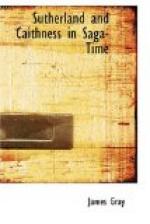Both parties, with their witnesses, accordingly crossed the North Sea in 1232, and Hakon heard the case, and punished the partisans of Snaekoll, some with death and others with imprisonment. Snaekoll himself, who, as the heir of Jarl Ragnvald, was too valuable a pawn to be sacrificed, was retained, and lived long in Norway with Earl Skuli, and afterwards with King Hakon.[21] It is noteworthy that a gaedinga ship (no Jewish Ship,[22] as Torfaeus states, but a ship of the gaedingar or lendirmen of the Earl of Orkney) was, on the return voyage, lost at sea; and, bearing in mind the large number of Orkney notables who had been slain at the battle of Floruvagr in Norway in 1194, men of means and standing must have been scarce in Orkney for long after this time.
There is a tradition mentioned by Alexander Pope of Reay,[23] the translator of the Orcades of Torfaeus, that Snaekoll, being deprived of his rights in Orkney by King Hakon, returned late in life to Caithness, where the Norse King could not deprive him of anything, and lived in that county at Ulbster. If so, why did he return?
The answer brings us to a mysterious lady, who is known to us through a charter[24] of May 1269 preserved in the Registrum Episcopatus Moraviensis or Chartulary of the Bishopric of Moray, and who is called therein nobilis mulier domina Johanna, the then deceased wife of Freskin de Moravia, Lord of Duffus, who had died before her. From her name of Johanna this lady is stated to have been a daughter of Earl John, amongst others by so eminent an authority as the late Mr. William F. Skene in a paper “on the Earldom of Caithness,” first read to the Society of Antiquaries of Scotland on the 11th March 1878, which is reprinted as Appendix V to the Third Volume of his Celtic Scotland at pages 448 to 453, and the lady is generally known as Lady Johanna de Strathnavir; and on her descent much subsequent history depends.
Skene’s conclusion is that the half of Caithness which afterwards belonged to the Angus earls was that half usually possessed by the line of Erlend Thorfinnson, and that Joanna (or Johanna) was Earl John’s daughter, and, as such, inherited the Paul share of the earldom and brought it to Freskin de Moravia, when he married her, without the title.
We doubt the accuracy of this conclusion, for reasons which, however, rest not on direct evidence, but, like those given in Mr. Skene’s paper, on mere probabilities; and we hold that the converse is true, and that Johanna was no daughter of John, and that it was the Erlend half of the Caithness earldom lands that went to her and her husband Freskin de Moravia of Duffus, while the moiety of Paul, in our opinion, remained with a nameless daughter of John, and went along with the title of Earl of Caithness, to her husband Magnus, and so to the Angus earls of Caithness, though the lands which went with it were then much curtailed in extent.




